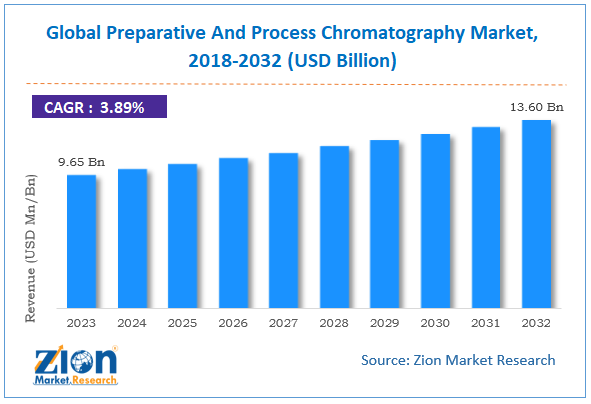Preparative And Process Chromatography Market Growth, Size, Share, Trends, and Forecast 2032
The preparative and process chromatography market is an essential segment within the broader chromatography industry, focusing on the large-scale separation and purification of chemical compounds, particularly in the pharmaceutical, biotechnology, food and beverage, and chemical industries. These chromatography techniques are crucial for the purification of active pharmaceutical ingredients (APIs), biopharmaceuticals, and other high-purity substances.

Get a Free Sample : https://www.zionmarketresearch.com/sample/preparative-process-chromatography-market
Key Market Insights
Market Growth Drivers:
- Increasing Demand for Biopharmaceuticals: The growing biopharmaceutical industry, particularly the development of monoclonal antibodies, vaccines, and other biologics, is driving demand for preparative and process chromatography systems, which are critical for the purification processes.
- Rising Focus on Research and Development: The increasing R&D activities in the pharmaceutical and biotechnology sectors, particularly for drug development and discovery, are boosting the demand for advanced chromatography systems.
- Regulatory Requirements: Stringent regulations related to the purity and quality of pharmaceutical products necessitate the use of high-efficiency chromatography techniques, further driving market growth.
- Technological Advancements: Continuous innovations in chromatography techniques, such as the development of high-throughput and automated systems, are enhancing the efficiency and scalability of preparative and process chromatography.
Market Segmentation:
- By Product Type:
- Instruments: Includes chromatography systems and columns used for large-scale purification processes.
- Resins: Critical for the separation process, with various types available, including ion-exchange, affinity, and size-exclusion resins.
- Columns: Specifically designed for preparative and process chromatography, these columns vary in size and configuration depending on the scale and application.
- Buffers and Solvents: Essential for the elution and separation of compounds during the chromatography process.
- Other Accessories: Includes detectors, pumps, and fraction collectors necessary for the chromatography process.
- By Technique:
- Liquid Chromatography (LC): The most widely used technique, particularly in biopharmaceutical purification.
- Gas Chromatography (GC): Used for the purification of volatile compounds.
- Ion-Exchange Chromatography: Utilized for the separation of charged molecules, particularly proteins and nucleic acids.
- Affinity Chromatography: Commonly used in the purification of antibodies, proteins, and enzymes.
- Size-Exclusion Chromatography: Employed for the separation of molecules based on size, often used in polymer and protein purification.
- By Application:
- Pharmaceutical & Biotechnology: The largest application segment, driven by the need for drug development, purification of APIs, and biopharmaceuticals.
- Food & Beverage: Used for quality control and purification of food additives and ingredients.
- Chemical: Applied in the purification of fine chemicals and specialty chemicals.
- Environmental Testing: Used in the purification and analysis of environmental samples.
- Others: Includes applications in academic research and diagnostics.
- By End-User:
- Pharmaceutical Companies: Major users of preparative and process chromatography for drug development and manufacturing.
- Biopharmaceutical Manufacturers: Focus on the purification of biologics, including monoclonal antibodies and recombinant proteins.
- Contract Research and Manufacturing Organizations (CROs and CMOs): Increasingly outsourcing drug development and manufacturing processes, driving demand for chromatography services.
- Academic and Research Institutes: Use chromatography for various research applications, including drug discovery and chemical analysis.
- Food and Beverage Companies: Utilize chromatography for quality control and ensuring the purity of products.
- By Product Type:
Geographical Insights:
- North America: The largest market, driven by the presence of major pharmaceutical and biotechnology companies, significant R&D activities, and advanced healthcare infrastructure.
- Europe: A strong market due to the robust pharmaceutical industry, government support for R&D, and stringent regulatory standards.
- Asia-Pacific: Expected to witness significant growth due to increasing investments in the pharmaceutical and biotechnology sectors, growing biopharmaceutical production, and expanding healthcare infrastructure.
- Latin America and Middle East & Africa: Emerging markets with increasing industrial activities and growing focus on pharmaceutical production and environmental testing.
Challenges:
- High Costs: The high initial investment and operational costs of preparative and process chromatography systems can be a barrier to adoption, particularly for small and mid-sized companies.
- Complexity of Processes: The technical complexity of chromatography processes requires skilled personnel, which can be a challenge in regions with a shortage of trained professionals.
- Regulatory Compliance: Meeting stringent regulatory requirements, especially in pharmaceutical applications, can be challenging and time-consuming, affecting the market's growth.
Competitive Landscape:
- Key Players: Major companies in the market include GE Healthcare (now Cytiva), Merck KGaA, Bio-Rad Laboratories, Thermo Fisher Scientific, and Danaher Corporation. These companies focus on expanding their product portfolios, strategic collaborations, and technological innovation to maintain market leadership.
- Product Innovation: There is a strong emphasis on developing next-generation chromatography systems that offer higher throughput, better scalability, and improved automation capabilities.
Future Trends
- Automation and Digitalization: The trend towards automation and the integration of digital technologies in chromatography systems is expected to continue, leading to more efficient, reproducible, and scalable processes.
- Single-Use Technologies: The adoption of single-use chromatography systems is expected to grow, particularly in biopharmaceutical manufacturing, due to their cost-effectiveness, reduced risk of cross-contamination, and faster turnaround times.
- Personalized Medicine: As the demand for personalized medicine increases, there will be a growing need for advanced chromatography techniques that can handle the purification of personalized biologics and other complex compounds.
- Sustainability Initiatives: The industry is likely to see a focus on developing more sustainable chromatography processes, including reducing solvent usage and waste, which could drive innovation in the market.
The preparative and process chromatography market is set for continued growth as the demand for high-purity substances in pharmaceuticals, biotechnology, and other industries increases. Technological advancements, along with the rise of biopharmaceuticals and personalized medicine, will play a critical role in shaping the future of this market.
Contact :
US OFFICE NO +1 (302) 444-0166
US/CAN TOLL FREE +1 (855) 465-4651
Email: sales@zionmarketresearch.com

Comments
Post a Comment